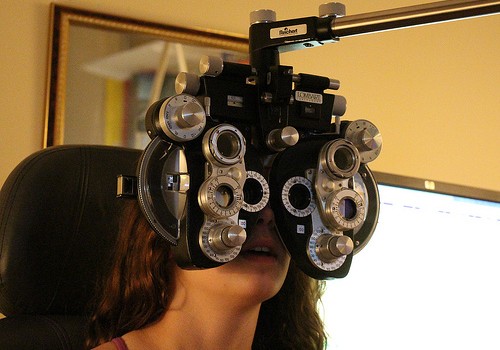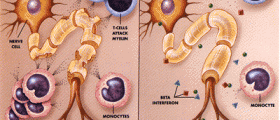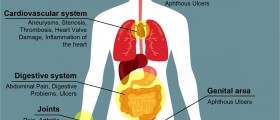
Multiple Sclerosis (MS) Is An Autoimmune Disorder
Multiple Sclerosis (MS) is an auto-immune disorder characterized by the degeneration of the nerves central nervous system (CNS). The brain and spinal cord make up the CNS. The spinal cord is responsible for collecting sensations from the nerve endings and transmitting them to the brain to process. After processing, the brain sends this information (called motor information) back to the body through the spinal cord, with the help of motor neurons. Multiple sclerosis is a disease that causes inflammation and demyelination (destruction of myelin sheath of neurons) of the CNS pathways. The damage to myelin sheaths impairs CNS function.

Are You At Risk Of Developing MS?
There is no particular group of people who will certainly develop Multiple Sclerosis. However, there are some factors that may increase the risk of developing this disease. Age: MS can occur at any age. But people between 20 and 40 years of age are more likely to develop MS. It rarely occurs during old age. Gender: The male to Female ratio for MS is 2:1. This means that women are twice as likely as men to develop the disease. Family History: If either of your parents is suffering from Multiple Sclerosis, you are at greater risk of developing the disease. However, it is not certain that you will develop MS. White Europeans are at the highest risk of developing Multiple Sclerosis, while native Americans are least likely to get MS.
- Important notification about information and brand names used in this slideshow!
- Photo courtesy of Oregon Chapter, National MS Society by Flickr : www.flickr.com/photos/defeatms/3906559835/
- www.mayoclinic.com/health/multiple-sclerosis/DS00188/DSECTION=risk-factors

What Causes MS?
The exact etiology (cause) of Multiple Sclerosis is still unknown. However, some scientists believe that a combination of factors are involved. Major scientific theories say that MS is caused by an auto-immune mediated process. An abnormal response of the body’s immune system starts to produce antibodies against its own myelin sheath. These antibodies damage the myelin sheath that results in development of multiple sclerosis. Some scientists believe that MS occurs more frequently in the areas furthest from equator. Some early childhood infections are known to cause MS because viruses are well recognized as causing demyelination.

What Does A Multiple Sclerosis Attack Feel Like?
MS has no clear disease pattern. It varies from person to person. It is a kind of a disease that keeps changing its target. One moment you might experience pain in your left knee, and the next moment your eyes are affected and you can’t see properly. MS usually occurs in a relapsing remitting pattern – on and off. When you get an MS attack, you develop a new symptom. For xxample, you have never had problems with your vision before, and suddenly the vision gets blurred. An MS attack worsens the symptoms already occurred before. Example, you had numbness in your left leg, but this time your leg gets paralyzed and you can’t feel anything. And after a period of time, the symptoms start to fade away. The disease can stay active for days, weeks or even months.

What Are The Types Of MS?
MS is divided into four categories depending upon the progression of the disease. Relapsing-Remitting MS (RRMS) – The symptoms occur at any time and fade away, leaving the attacked part healthy without any traces of the disease. This is the most common type. Secondary-Progressive MS (PPMS) – The symptoms occur and fade away with time but this type leaves traces behind in the affected areas. Recoveries are partial. Primary-Progressive MS (PPMS) – This type of MS progresses slowly after its onset. The symptoms develop steadily and increase in intensity with passing time. There is no recovery. Progressive-Relapsing MS (PRMS) – A rare type of MS. The symptoms keep worsening with attacks of MS.
- Important notification about information and brand names used in this slideshow!
- Photo courtesy of Jason Corneveaux by Flickr : www.flickr.com/photos/corneveaux/4944172309/
- www.mayoclinic.org/multiple-sclerosis/types.html

What Are The Symptoms Of MS?
You must keep in mind that no two people have the same symptoms with Multiple Sclerosis. It affects different patients in different ways. The earlier symptoms of MS are usually visual. Double or blurred vision is one of the most common symptoms of early stage MS. Tingling and numbness in the extremities is strongly associated with MS. Besides that, we can also find symptoms such as lack of coordination, thinking problems, loss of balance, or weakness in arms or legs. MS can also cause walking problems as it causes muscle weakness or muscle spasms.

Muscle Spasms
Muscle stiffness or spasms affect at least 20 percent of people with multiple sclerosis at some time. Like all the other symptoms of MS, stiffness and spasms affect people differently and can vary over time. Muscle spasms occur because of nerve damage caused by MS. It affects muscle movements and can cause range of problems. Muscle spasms and stiffness can range from a minor irritation to problems that may make your daily life and activities painful, difficult, and uncomfortable. Spasms are known to cause particular problems at night. Physiotherapy is a good way to get some relief from stiffness and spasms.

MS Impairs Walking
MS is a disease that affects the different parts of the body. It affects your gait as well. If a person is diagnosed with MS, eventually he will need some kind of mobility device such as a walker, scooter, or cane. Demyelination of the myelin sheath causes the muscle tone to increase to an extent that it causes spasticity or stiffness in your limbs. With spasticity, patients also complain about fatigue and lassitude. Regular activities like walking or climbing stairs may begin to feel like marathons. Dizziness, vertigo, and sensory changes occur after MS has developed. These factors also make it quite difficult for a patient to walk normally.

Eyes Are The Primary Victim Of MS
Eight percent of MS patients has vision problems. Vision problems are often temporary. Blurred or double vision, visual limitations, or eye pain are common symptoms seen in patients who have developed MS. Vision problems are one of the first symptoms of relapsing MS. Vision problems begin to occur when MS attacks the optic nerve – the nerve that transmits visual images and light to the brain. Visual disorders associated with MS include: Optic Neuritis – inflammation of optic nerve Diplopa – double vision Nystagmus – uncontrolled eye movements According to some doctors, a rise in body temperature can also cause vision problems. Heat-related vision problems fade away after you cool off.

How Can You Fight MS?
As you know, MS has no particular clinical picture. It varies from person to person. MS treatment is mostly symptomatic, which means that you treat the symptoms rather than the disease. Corticosteroids are known to help speed up recovery from a relapse. Disease-modifying drugs (DMDs) are the only proven treatment of MS so far. They are clinically proven to change the course of the disease. These drugs help by slowing the progression of the disease down, reducing the relapse frequency, and reducing the development of brain lesions. The effects of DMDs also vary from person to person, so it may take some experimentation to find the right DMD for you.

Interferon and Multiple Sclerosis
What's Inside : - Five patients who were on interferon for four conditions share their real-life experiences - Interferon facts your doctor didn’t share - A bonus interferon fact sheet — all important data on a single page - All the research — already done for you! - Possible alternative to interferon for your condition - Updates and news about interferon in your inbox - Become a part of the SteadyHealth community to talk about interferon and the conditions it treats http://www.steadyhealth.com/interferon-side-effects/
- Important notification about information and brand names used in this slideshow!
- Slide by steadyhealth.com



























Your thoughts on this
Loading...